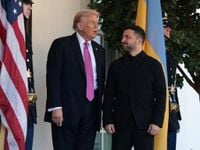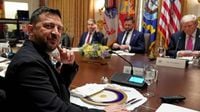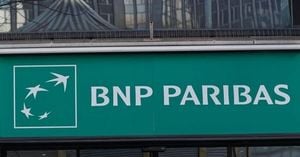On October 17, 2025, the White House was once again the epicenter of high-stakes diplomacy as President Donald Trump welcomed Ukrainian President Volodymyr Zelenskyy for a pivotal meeting. The stakes: the future of the Russia-Ukraine war, Ukraine’s urgent request for American Tomahawk cruise missiles, and the shape of peace in Eastern Europe. The atmosphere was markedly more cordial than previous encounters, reflecting a shift in the dynamic between the two leaders and the broader geopolitical chessboard they inhabit.
Zelenskyy, who has become a familiar face in Washington since the Russian invasion began in February 2022, arrived with a clear message. “President Trump has a big chance now to finish this war,” he declared during a working lunch, referencing Trump’s recent brokering of a ceasefire between Israel and Hamas. According to ABC News, Zelenskyy underscored the momentum generated by that Middle East breakthrough, expressing hope that similar diplomatic energy could bring Russia’s three-and-a-half-year assault on Ukraine to an end. “That’s why I hope that he will do this, and we will also have such big success for Ukraine,” he added.
The meeting came just one day after Trump’s lengthy phone call with Russian President Vladimir Putin, a conversation described by the White House as “very productive.” The call set the stage for a planned face-to-face summit in Budapest in the coming weeks—Putin’s first return to European Union soil since the start of the war, despite ongoing EU sanctions. As reported by Sky News, this timing was no accident; the Kremlin, acutely aware of Trump’s shifting sympathies, initiated the call in a bid to stave off the possibility of U.S. Tomahawk missiles reaching Kyiv—a move Moscow sees as a dangerous escalation.
Trump’s tone following the call was notably conciliatory. “We’re in it to see that end and if we can end it quickly, and I think we can. ... We’ll see what happens. But the war in the Middle East was far more complicated. We got that one done. And I think we have a good chance,” Trump told reporters, as quoted by ABC News. On his social media platform, he went further, suggesting, “They should stop where they are. Let both claim Victory, let History decide! No more shooting, no more Death, no more vast and unsustainable sums of money spent.”
Yet, beneath the surface optimism, the path forward remains fraught. Trump, once bullish about arming Ukraine, expressed fresh reservations after his conversation with Putin. “That’s a problem. We need Tomahawks and we need a lot of other things that we’ve been sending over the past four years to Ukraine,” he said, highlighting concerns about depleting U.S. military stockpiles. “We’d much rather have them not need Tomahawks,” Trump added. “Would much rather have the war be over, to be honest.”
Zelenskyy, ever pragmatic, floated a potential exchange: American Tomahawks in return for Ukrainian drones. Trump, for his part, said he was open to the idea, but stopped short of making any commitments. “They’re a very powerful weapon, but they’re a very dangerous weapon, and it could mean big escalation,” Trump explained, according to Al Jazeera. “One thing I have to say: We want Tomahawks also. We don’t want to be giving away things that we need to protect our country.”
Despite the uncertainty over weapons, both leaders voiced cautious optimism about the prospect of peace. Zelenskyy told reporters, “I think this is a momentum to finish Russia’s war against Ukraine.” He acknowledged, however, that Putin “is not ready” for a settlement, but expressed confidence in Trump’s ability to help stop the war. “I think that I’m confident that, with your help, we can stop this war, and we really need it.”
While direct talks between Putin and Zelenskyy remain unlikely—Trump cited “a lot of blood” between the two presidents—the upcoming Budapest summit is set to be a double meeting, with Zelenskyy “in touch” but not at the table. “I would say most likely it’s going to be a double meeting,” Trump said, referencing the deep mistrust between the Ukrainian and Russian leaders.
For Zelenskyy, the U.S. relationship is about more than just hardware. He emphasized the importance of bilateral security guarantees, suggesting that even if NATO membership remains out of reach, a strong defense pact with the United States could serve as a crucial deterrent. “For us, bilateral security guarantees between me and President Trump is very important. I don’t know, we didn’t speak with details about it, but this is the most important document because the United States is very strong,” he said, as reported by Al Jazeera.
The skepticism of Ukraine and its European allies is palpable. Sky News points out that this diplomatic dance has played out before: symbolic breakthroughs, deadlines, and summits that have failed to deliver lasting progress. The Alaska summit in August 2025, for instance, yielded little more than photo ops. Each time, Putin’s approach—offering just enough to keep negotiations alive while avoiding concrete concessions—has bought him valuable time on the battlefield.
Trump himself acknowledged the risk of being strung along. “I’ve been played all my life by the best of them, and I came out really well, so it’s possible – a little time,” he told reporters. “It’s all right, but I think that I’m pretty good at this stuff. I think that he wants to make a deal.”
Putin’s strategy, as described by Sky News, hinges on flattery and symbolic gestures. In the latest call, he congratulated Trump on his “great accomplishment” in Gaza, thanked the first lady for her advocacy on Ukraine’s missing children, and agreed to another summit. The optics of returning to EU soil in Budapest—despite sanctions—are a diplomatic coup for the Russian leader, who is keen to present himself as a legitimate interlocutor on the world stage.
On the ground, the war remains a grinding stalemate, with Russian forces entrenched in eastern Ukraine and Ukrainian troops pushing for Western support. The Biden administration’s unwavering backing for Kyiv has given way to Trump’s more transactional, unpredictable approach. While Trump has at times asserted that Ukraine can reclaim its lost territory, he has also floated the idea of freezing the conflict and letting “history decide” the outcome.
As negotiations loom, the world watches to see whether the Budapest summit will break the cycle of delay and disappointment—or simply provide another stage for political theater. Zelenskyy, for his part, remains realistic. “We want peace. Putin doesn’t want. That’s why we need pressure on him,” he said, emphasizing that Ukraine did not start this war and remains committed to a just resolution.
The coming weeks will test not only the resolve of Ukraine and its allies but also the limits of personal diplomacy in the face of hard geopolitical realities. Whether Trump’s self-proclaimed deal-making prowess can deliver where past efforts have failed is, for now, an open question. But one thing is clear: the stakes, for Ukraine and for Europe, have never been higher.





